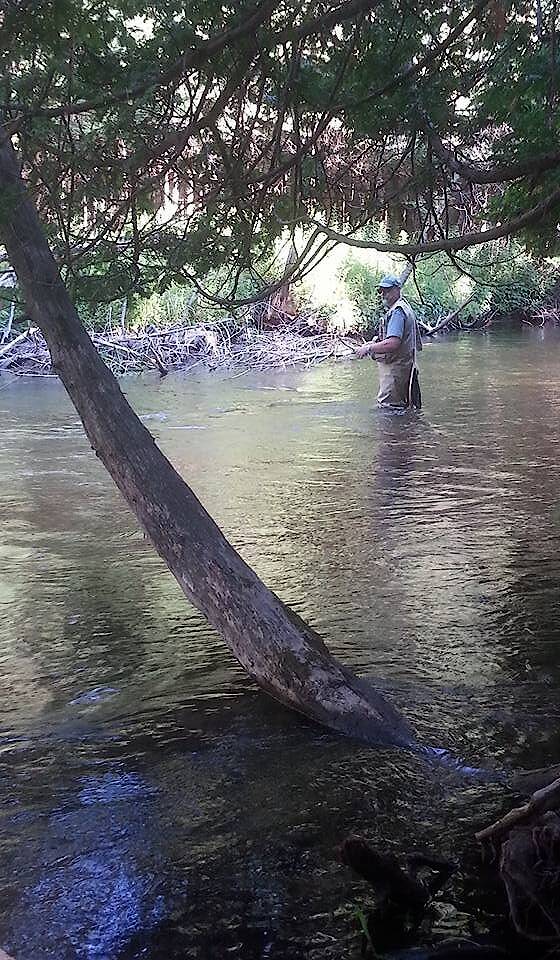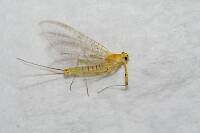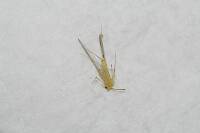
Blue-winged Olives
Baetis
Tiny Baetis mayflies are perhaps the most commonly encountered and imitated by anglers on all American trout streams due to their great abundance, widespread distribution, and trout-friendly emergence habits.
Featured on the forum

Troutnut is a project started in 2003 by salmonid ecologist Jason "Troutnut" Neuswanger to help anglers and
fly tyers unabashedly embrace the entomological side of the sport. Learn more about Troutnut or
support the project for an enhanced experience here.
Roguerat on Jul 21, 2018July 21st, 2018, 8:07 am EDT
Just came off a 3 day road trip with our oldest grandsons and a promised tour of the shipwrecks in Thunder Bay, Alpena MI. Not a fishing expedition and we just played tourist but I saw many, many Hexes in all kinds of condition- duns that were extremely healthy, spinners, and one that is the topic of this post- a fully-formed, dead adult that had its wings apparently stuck in the shuck of the dun it was molting out of. Is this even possible?
I carefully picked it off the wall it was stuck to and now have it on my tying bench as the prototype for some cripple patterns I'm experimenting with.
I'll try to get some decent photos and post them soon, but wanted to put this topic out there for input from the Entomology TN's.
BTW the Hexes we saw were all on glass surfaces or walls- dozens and dozens of them, just hanging there.
Roguerat
'Less is more...'
Ludwig Mies Vande Rohe
I carefully picked it off the wall it was stuck to and now have it on my tying bench as the prototype for some cripple patterns I'm experimenting with.
I'll try to get some decent photos and post them soon, but wanted to put this topic out there for input from the Entomology TN's.
BTW the Hexes we saw were all on glass surfaces or walls- dozens and dozens of them, just hanging there.
Roguerat
'Less is more...'
Ludwig Mies Vande Rohe
Taxon on Jul 21, 2018July 21st, 2018, 9:47 am EDT
Hi Roguerat-
Yes, not only possible, it is predicable that some mayfly duns will not be successful in their attempt to shed their external skeleton upon emerging as a subimago, and/or their subsequent transformation to an imago. If you picked it it off the wall, it must have gotten stuck in the process of transforming to an imago. Otherwise, it would have been unable to fly to the wall.
In any event, pattern many use to imitate unsuccessful emergence is called a Quigley Cripple. You probably already knew that, but some others may not have.
Yes, not only possible, it is predicable that some mayfly duns will not be successful in their attempt to shed their external skeleton upon emerging as a subimago, and/or their subsequent transformation to an imago. If you picked it it off the wall, it must have gotten stuck in the process of transforming to an imago. Otherwise, it would have been unable to fly to the wall.
In any event, pattern many use to imitate unsuccessful emergence is called a Quigley Cripple. You probably already knew that, but some others may not have.
Roguerat on Jul 21, 2018July 21st, 2018, 10:26 am EDT
Roger-
Correct, it was a Dun with the spinner form emerging from it when things went bad. Thanks for the confirmation, this one was puzzling...I've seen stuck-in-the shuck emergers in nymph form but never in the subimago/imago transition.
An interesting fly to see! And it is a long fly, I'm using sz 10 3LX hooks to tie on just to equal the natural's proportions.
Roguerat
'Less is more...'
Ludwig Mies Vande Rohe
Correct, it was a Dun with the spinner form emerging from it when things went bad. Thanks for the confirmation, this one was puzzling...I've seen stuck-in-the shuck emergers in nymph form but never in the subimago/imago transition.
An interesting fly to see! And it is a long fly, I'm using sz 10 3LX hooks to tie on just to equal the natural's proportions.
Roguerat
'Less is more...'
Ludwig Mies Vande Rohe
Quick Reply
Related Discussions
Topic
Replies
Last Reply






